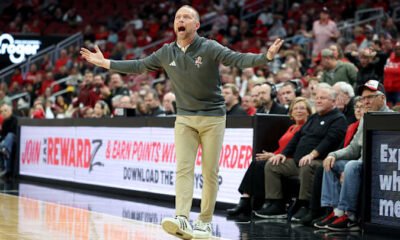Blog
Derek Carr could be out for the Saints in 2025. Here are Kellen Moore’s choices as quarterback.
As the 2025 NFL season looms ever closer, the New Orleans Saints find themselves at a crucial crossroads at the quarterback position. With veteran signal-caller Derek Carr now facing a potentially season‐ending shoulder injury, the future under center is fraught with uncertainty. In the midst of this turmoil, newly appointed head coach Kellen Moore is tasked with steering an offense that is highly dependent on strong quarterback play. Moore’s deep background as an offensive mind and his innovative approach have earned him respect around the league. Yet the current state of the quarterback room—and the looming draft—mean that he now faces some tough choices. In this article, we delve into the impact of Carr’s injury on the Saints’ season and explore the range of options available to Moore, from veteran free-agency targets to promising rookie prospects.
The Derek Carr Dilemma
Derek Carr’s tenure in New Orleans has been a roller-coaster. After signing a lucrative four‐year, $150 million contract in 2023 and being viewed as the long-term franchise quarterback, Carr’s on-field performance has been marred by injuries. Last season, he saw action in only 10 games—missing crucial time due to oblique, hand, and now shoulder injuries. His limited play came at a high cost: while he posted a respectable 67.7% completion rate in those appearances, his statistics were compromised by the interruptions and the defensive adjustments opponents made knowing the starter was not at full strength.
Recently, multiple reports have confirmed that Carr is weighing his options, including the possibility of surgery to repair his shoulder. This development has dramatic implications. A significant injury for a veteran quarterback is not only a blow to the team’s immediate offensive plans, but also a major factor in financial and roster planning. With Carr’s future in jeopardy, and the Saints’ restructuring of his contract having converted a large portion of his salary into a signing bonus to keep him around, the franchise is now forced to ask: should they continue to commit to Carr, or should they pivot and search for a new signal caller entirely?
Kellen Moore’s Offensive Mandate
Taking over a team that once boasted a stable quarterback figure like Carr puts added pressure on Kellen Moore. Known for his analytical approach to offensive play and his track record of developing young quarterbacks, Moore now faces the daunting task of choosing his long-term answer at the position. His offensive philosophy centers on versatility, quick decision-making, and an attack that spreads the field. Moore’s previous stops have demonstrated that given the right personnel and scheme, he can elevate quarterbacks to new levels of production.
With Carr’s potential absence in 2025, Moore must decide whether to invest in a transition plan that relies on a veteran presence to bridge the gap, or whether to turn the page completely and draft or acquire a younger quarterback who fits his modern offensive mold. Ultimately, his decision will influence not only the team’s performance next season but also the long-term trajectory of the franchise.
Evaluating the Options: Veterans, Rookies, or In-House Talent?
At this juncture, the Saints’ quarterback situation is far from black and white. The options available broadly fall into three categories:
1. Veteran Free-Agency or Trade Targets
Aaron Rodgers.
One of the most talked-about options is veteran quarterback Aaron Rodgers. Despite his storied career and tendency to attract headlines wherever he goes, Rodgers’s availability in free agency remains an open question. Some reports suggest that Rodgers may be looking for a change after a tumultuous offseason elsewhere in the league. For Moore, signing a veteran quarterback like Rodgers would come with some inherent benefits. His experience, quick processing ability, and familiarity with complex offensive schemes could provide immediate stability while the Saints regroup. However, there are questions regarding Rodgers’s willingness to join a team with an uncertain quarterback future and a rebuilding window ahead. Additionally, salary cap implications must be considered—while the Saints have some cap space available, the high cost associated with a quarterback of Rodgers’s caliber might limit future flexibility.
Carson Wentz.
Another potential veteran option is Carson Wentz. Once heralded as a franchise quarterback before injuries and inconsistency marred his trajectory, Wentz remains on the radar as a possible bridge starter. He has spent time on multiple rosters recently and could be available for a one-season stint that gives Moore time to develop a long-term prospect. Although Wentz has not produced at the elite level in recent years, his knowledge of the game and ability to manage games could be seen as an asset in a transitional period. The main concern here is that his style of play may not perfectly align with the dynamic, fast-paced offense that Moore envisions. Moreover, there is always the risk that a veteran known for ups and downs may only serve as a stopgap, delaying the necessary transition.
Ryan Tannehill.
A further veteran possibility is Ryan Tannehill, who has demonstrated flashes of consistent play and leadership over his career. Though not as prolific as he once was, Tannehill offers a reliable, if not spectacular, option in the veteran free-agent market. Bringing in someone like Tannehill could give the team a steady hand while the franchise positions itself for the future. However, his declining physical attributes and the fact that he is nearing the twilight of his career may not make him an ideal long-term solution.
2. Drafting a New Quarterback
With the 2025 NFL Draft less than two weeks away and the Saints holding the coveted No. 9 overall pick, the option to select a rookie quarterback who fits Moore’s offensive system has become increasingly appealing.
Shedeur Sanders.
One of the most promising prospects in this scenario is Colorado’s Shedeur Sanders. After a season marked by impressive efficiency—completing 74% of his passes under relentless pressure—Sanders has emerged as a top-10 lock in many mock drafts. Analysts have been vocal in their support of a matchup between Sanders and the Saints; his skill set aligns closely with the traits that Moore values: quick decision-making, accuracy, and an innate ability to distribute the ball effectively to his playmakers. The advantage of drafting a quarterback like Sanders is multifold: he comes on a rookie contract with significant salary cap relief, he has a high ceiling for growth, and he can initially serve as a developmental player behind Carr if needed. With Carr’s injury casting doubt over his 2025 availability, the timing appears almost serendipitous for the Saints to upgrade at quarterback via the draft.
Jaxson Dart.
Another intriguing option is Ole Miss product Jaxson Dart. While not as widely touted as Sanders, Dart’s blend of arm strength and mobility has caught the eye of several NFL scouts. Moore’s offensive philosophy could very well be a good fit for Dart, whose play style has drawn comparisons to dual-threat quarterbacks in the league. Drafting Dart—either at No. 9 or later in the draft—could offer a fresh start and a long-term solution. However, the risk with any rookie draft pick is that development is not guaranteed; it might take a season or two before he adapts to the NFL’s pace and complexity.
3. Relying on In-House Talent
The Saints are not without internal options. Currently on the roster are Spencer Rattler, Jake Haener, and Ben DiNucci—three quarterbacks who have shown varying degrees of promise but have, as of yet, not delivered consistent success.
Spencer Rattler.
Drafted in the fifth round of the 2024 NFL Draft, Spencer Rattler has had a challenging start to his professional career. Last season, his numbers were far from inspiring, with a 57% completion percentage, modest yardage, and a 70.4 passer rating. While Rattler has the advantage of being familiar with the team’s culture and scheme, his performance so far leaves many questions about his readiness to shoulder a full season as the starter. For Moore, the decision to rely on Rattler would be a gamble—one that might work in a homegrown development scenario but could also set the team back if he is unable to elevate his game quickly.
Jake Haener and Ben DiNucci.
Similarly, Jake Haener and Ben DiNucci represent additional internal candidates who might be given a chance to prove themselves. Haener, a fourth-round pick, has struggled with efficiency in his limited opportunities, while DiNucci’s stints with the team have been marked by inconsistency. Neither option exudes the promise of being an immediate upgrade. However, in the absence of a reliable veteran or a sure-thing rookie, the Saints might be forced to call on one of these players—at least on a temporary basis—while pursuing external options.
The Strategic Implications for the Saints
The quarterback position is undeniably the most critical on the field, and the Saints’ situation is emblematic of the challenges that even storied franchises face when a key player falls victim to injury. For the Saints, the decision that Moore makes now will reverberate throughout the organization. There are several strategic factors to consider:
Short-Term Competitiveness vs. Long-Term Vision.
If the Saints opt for a veteran such as Rodgers or Tannehill, they may secure short-term stability at the quarterback position. This could be beneficial for a team that is vying for immediate playoff contention. However, the downside is that veteran contracts are expensive and can hamper salary cap flexibility. Additionally, committing to a veteran does not necessarily build for the future. In contrast, drafting a young quarterback on a rookie deal offers long-term promise and salary cap advantages, but it might mean accepting some growing pains in the near term.
Development Under Kellen Moore.
Moore’s track record of developing quarterbacks cannot be overstated. His offensive schemes typically rely on quarterbacks who can read defenses quickly and distribute the ball to a versatile group of receivers. Ideally, a rookie like Shedeur Sanders or Jaxson Dart would not only fit this mold but would also have the benefit of learning from a veteran like Carr—if he is healthy enough to mentor even in a limited capacity. Alternatively, if Carr is sidelined for an extended period, Moore may have to convert his offensive focus entirely around his new quarterback. This represents both a risk and an opportunity: a risk because an untested rookie might struggle with a heavy workload, and an opportunity because a high-ceiling prospect could evolve into a franchise cornerstone.
Financial Considerations.
The restructuring of Carr’s contract and his associated cap hit have already signaled that the Saints are aware of the financial risks involved. A veteran quarterback on a high salary could stifle the team’s ability to address other needs. In contrast, a rookie quarterback comes on a much more cost-effective contract, preserving resources for other areas of the roster. Given that the salary cap in the NFL is unforgiving, especially in a rebuilding window, this factor could tip the scales in favor of drafting a young quarterback.
Weighing the Pros and Cons
In summary, here is a closer look at the critical factors associated with each option:
- Veteran Acquisition (Rodgers, Wentz, Tannehill):
Pros:
– Immediate experience and leadership at quarterback.
– Potential to stabilize the offense quickly during a turbulent transition.
– Familiarity with complex offensive schemes.Cons:
– High salary demands may limit future cap space.
– Risk of not fully aligning with Moore’s offensive philosophy.
– Shorter window of peak performance; may not offer long-term continuity. - Drafting a Rookie (Shedeur Sanders, Jaxson Dart):
Pros:
– Significant cost savings with a rookie contract.
– High upside potential; the opportunity to mold a quarterback in Moore’s system.
– Possibility of immediate franchise-building impact if the prospect adapts quickly.Cons:
– Developmental period may lead to short-term struggles.
– Greater uncertainty regarding immediate readiness for an NFL starting role.
– Reliance on future success in a more pass-oriented and fast-paced offensive system. - Utilizing In-House Talent (Rattler, Haener, DiNucci):
Pros:
– Familiarity with the team’s offensive scheme and culture.
– Minimal disruption to the locker room.
– Possibility of a low-cost solution if one emerges as unexpectedly effective.Cons:
– Currently, the production and consistency of these players have been subpar.
– Their track records do not instill confidence that they can be instant starters.
– Could further delay the necessary acquisition of a long-term solution, impacting competitive balance.
Looking Ahead: A Potential Roadmap for the 2025 Season
Given the high stakes of the quarterback decision, the path that the Saints choose over the next few weeks will likely set the tone for the entire season—and even the franchise’s future. Should Carr’s injury prompt the team to pivot toward youth and long-term stability, it may be that the draft becomes the primary vehicle for change. In such a scenario, the focus would be on a “QB for the Future,” a player who can learn from the veteran presence of Carr (if he returns later in the season or in a mentoring role) while developing into the centerpiece of Moore’s innovative offense. Analysts already favoring the potential pairing of the Saints with a prospect like Shedeur Sanders underscore the alignment between his skill set and the offensive identity that Moore seeks to create.
Alternatively, if the organization prioritizes immediate competitiveness and stability—perhaps driven by pressure to make the playoffs—the window could narrow to veteran free agents. In this case, the Saints might need to stretch financially to sign a proven quarterback who can manage the game with limited time to learn a new system. However, with most available veterans having their own uncertainties and financial baggage, this path is riddled with risk.
It is also conceivable that the Saints might adopt a hybrid approach: relying on a veteran while simultaneously securing a high draft pick to serve as the eventual successor. Such a strategy would allow Moore to maintain competitive balance in the short term while laying the foundation for a long-term transition. However, carrying two quarterbacks—one on a veteran deal and one as a developing prospect—requires careful salary cap management and can complicate the locker room dynamic.
Conclusion
The quarterback position is often described as the most important in football, and for the New Orleans Saints, this axiom has never been more relevant. With Derek Carr facing a shoulder injury that threatens to derail his 2025 season, the franchise is compelled to reexamine its options at one of the league’s most critical positions. Kellen Moore now finds himself at a pivotal crossroads: the decision he makes will influence not only the upcoming season but the long-term identity of the team.
The options before him are as varied as they are challenging. Veteran free agents like Aaron Rodgers, Carson Wentz, or even Ryan Tannehill offer the allure of immediate stability and leadership but come at a high financial and strategic cost. On the other hand, the draft presents an opportunity to secure a young, cost-effective quarterback—an option that aligns with Moore’s history of offensive innovation and quarterback development. Yet drafting a rookie carries the inherent risk of a transitional period that might hinder short-term performance. Meanwhile, relying on in-house talent such as Spencer Rattler, Jake Haener, or Ben DiNucci is an option fraught with uncertainty given their inconsistent play so far.
Ultimately, the future of the Saints’ offense—and indeed the franchise’s competitive window—rests on how these trade-offs are evaluated. In a league where the margin between victory and defeat is razor-thin, Moore’s choice at quarterback will set the tone for what could either be a swift return to contention or a prolonged period of rebuilding. As the 2025 NFL Draft approaches and free agency continues to evolve, one thing is clear: the Saints are facing one of the most critical decisions of the modern NFL era, and the eyes of the league will be watching closely to see what path they choose.
In the end, whether the Saints decide to usher in a new era with a promising rookie or lean on the experience of a seasoned veteran, the quarterback conundrum highlights the inherent challenges of building an NFL team around the most demanding position in sports. For Kellen Moore and his staff, there is no easy answer—only the difficult process of balancing immediate needs with long-term aspirations, all under the unyielding pressure of professional football.
-

 Blog6 months ago
Blog6 months ago“Courtside to Aisle-Side: Tyrese Haliburton and Jade Jones Set New Wedding Date”
-

 Blog6 months ago
Blog6 months agoPat Kelsey sends a strong three-word fiery message to the Louisville basketball’s team after their Cardinals 14th win…
-

 Blog8 months ago
Blog8 months agoNetflix releases “The Underdog,” a much-anticipated documentary about Drew Brees. slated for publication on the 25th
-

 Blog6 months ago
Blog6 months agoMikaela Shiffrin responds to cross-country skier Jessie Diggins’ letter following her failure to secure a solitary podium finish at the FIS Nordic Worlds
-

 Blog4 months ago
Blog4 months agoBehind the Turns: Netflix’s Upcoming Documentary on Mikaela Shiffrin’s Fights, Fears, and Love
-

 Blog5 months ago
Blog5 months agoLegacy Tour Led Zeppelin has officially confirmed their 2026 reunion tour, which will be their first extensive live performances since 2007. The “Led Zeppelin Legacy Tour 2026” will begin on June 10, 2026, at Los Angeles’ SoFi Stadium.
-

 Blog6 months ago
Blog6 months agoWomen’s Slalom Run 1 at the FIS Alpine Skiing World Cup: Are
-

 Blog8 months ago
Blog8 months agoFederica Brignone: “I’m fine, but my return to skiing is far off.”
